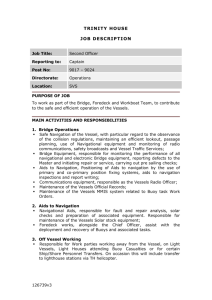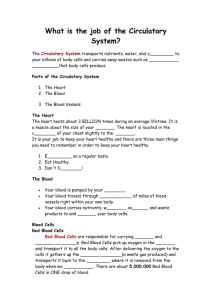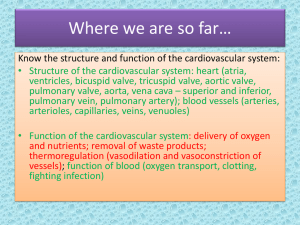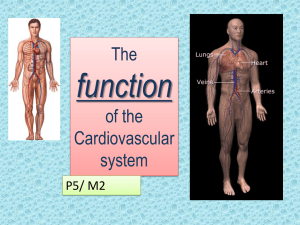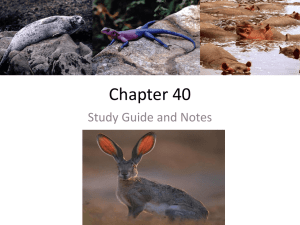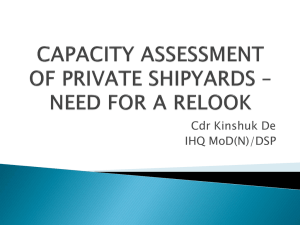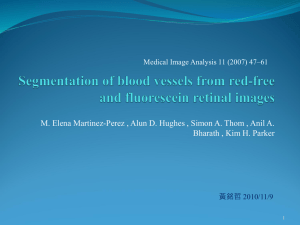Establishment of Engineered Functional Micro
advertisement
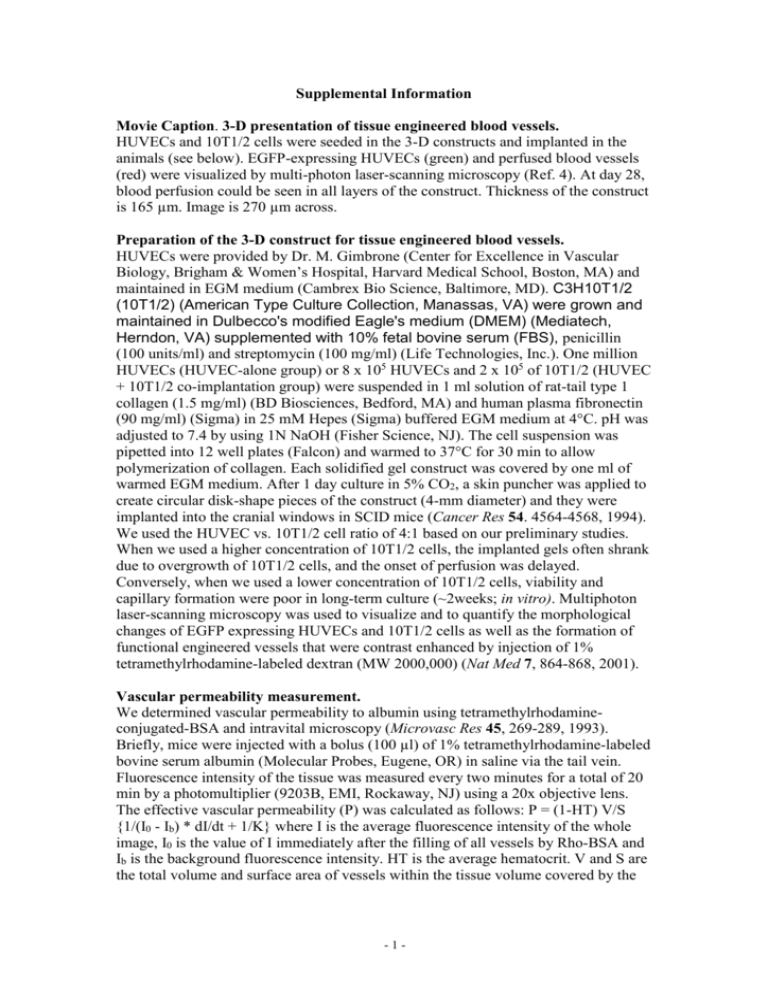
Supplemental Information
Movie Caption. 3-D presentation of tissue engineered blood vessels.
HUVECs and 10T1/2 cells were seeded in the 3-D constructs and implanted in the
animals (see below). EGFP-expressing HUVECs (green) and perfused blood vessels
(red) were visualized by multi-photon laser-scanning microscopy (Ref. 4). At day 28,
blood perfusion could be seen in all layers of the construct. Thickness of the construct
is 165 µm. Image is 270 µm across.
Preparation of the 3-D construct for tissue engineered blood vessels.
HUVECs were provided by Dr. M. Gimbrone (Center for Excellence in Vascular
Biology, Brigham & Women’s Hospital, Harvard Medical School, Boston, MA) and
maintained in EGM medium (Cambrex Bio Science, Baltimore, MD). C3H10T1/2
(10T1/2) (American Type Culture Collection, Manassas, VA) were grown and
maintained in Dulbecco's modified Eagle's medium (DMEM) (Mediatech,
Herndon, VA) supplemented with 10% fetal bovine serum (FBS), penicillin
(100 units/ml) and streptomycin (100 mg/ml) (Life Technologies, Inc.). One million
HUVECs (HUVEC-alone group) or 8 x 105 HUVECs and 2 x 105 of 10T1/2 (HUVEC
+ 10T1/2 co-implantation group) were suspended in 1 ml solution of rat-tail type 1
collagen (1.5 mg/ml) (BD Biosciences, Bedford, MA) and human plasma fibronectin
(90 mg/ml) (Sigma) in 25 mM Hepes (Sigma) buffered EGM medium at 4°C. pH was
adjusted to 7.4 by using 1N NaOH (Fisher Science, NJ). The cell suspension was
pipetted into 12 well plates (Falcon) and warmed to 37°C for 30 min to allow
polymerization of collagen. Each solidified gel construct was covered by one ml of
warmed EGM medium. After 1 day culture in 5% CO2, a skin puncher was applied to
create circular disk-shape pieces of the construct (4-mm diameter) and they were
implanted into the cranial windows in SCID mice (Cancer Res 54. 4564-4568, 1994).
We used the HUVEC vs. 10T1/2 cell ratio of 4:1 based on our preliminary studies.
When we used a higher concentration of 10T1/2 cells, the implanted gels often shrank
due to overgrowth of 10T1/2 cells, and the onset of perfusion was delayed.
Conversely, when we used a lower concentration of 10T1/2 cells, viability and
capillary formation were poor in long-term culture (~2weeks; in vitro). Multiphoton
laser-scanning microscopy was used to visualize and to quantify the morphological
changes of EGFP expressing HUVECs and 10T1/2 cells as well as the formation of
functional engineered vessels that were contrast enhanced by injection of 1%
tetramethylrhodamine-labeled dextran (MW 2000,000) (Nat Med 7, 864-868, 2001).
Vascular permeability measurement.
We determined vascular permeability to albumin using tetramethylrhodamineconjugated-BSA and intravital microscopy (Microvasc Res 45, 269-289, 1993).
Briefly, mice were injected with a bolus (100 µl) of 1% tetramethylrhodamine-labeled
bovine serum albumin (Molecular Probes, Eugene, OR) in saline via the tail vein.
Fluorescence intensity of the tissue was measured every two minutes for a total of 20
min by a photomultiplier (9203B, EMI, Rockaway, NJ) using a 20x objective lens.
The effective vascular permeability (P) was calculated as follows: P = (1-HT) V/S
{1/(I0 - Ib) * dI/dt + 1/K} where I is the average fluorescence intensity of the whole
image, I0 is the value of I immediately after the filling of all vessels by Rho-BSA and
Ib is the background fluorescence intensity. HT is the average hematocrit. V and S are
the total volume and surface area of vessels within the tissue volume covered by the
-1-
surface image, respectively. The time constant of BSA plasma clearance (K) was 9.1
x 103 s.
Vascular permeability of the engineered vessels was determined at Day 36-38 when
the perfused vessels in both co-implantation constructs and HUVEC-alone constructs
were relatively stable (Fig. 1c). The rare perfused vessels in HUVEC-alone constructs
were predominantly localized at the periphery of the construct, so the measured
values contain contributions from the vessels of the host tissue. On the other hand,
perfused vessels were abundant in HUVEC + 10T1/2 constructs and regions of
interest were chosen randomly. The vascular permeability was 1.33 ± 0.47 x 10-7 cm
s-1 and 1.32 ± 0.54 x 10-7 cm s-1 in HUVEC + 10T1/2 and HUVEC-alone groups,
respectively, (n=6 each, NS). These values are higher than that of normal quiescent
vessels (0.3-0.6 x 10-7 cm s-1, Cancer Res. 59: 4129-4135, 1999), but in the lower part
of the range of tumour vessel permeabilities (2,9-3.9 x 10-7 cm s-1, Cancer Res 54,
4564-5568, 1994; Cancer Res 59, 4129-4135, 1999) and of permeabilities induced by
various angiogenic molecules (2.5-4.9 x 10-7 cm s-1, Am J Pathol 149, 59-71, 1996;
PNAS 98, 2604-2609, 2001).
Arteriolar contractility assay.
Arteriolar contractility was determined by vasoactive response to endothelin-1 (ET1). After careful removal of the cover glass, the cranial window was superfused with
warm PBS. For vessel contrast enhancement, 100 µl of 1% tetramethylrhodamine dextran (MW 2 million) was injected i.v. The engineered vessels were monitored by
single photon fluorescence intravital microscopy using a 20x water-immersion
objective. After the baseline measurements, superfusate was replaced with 100 nM
ET-1 in PBS. Then, the same regions were repeatedly monitored over 30 min. We
used 100 nM ET-1 for the study of arterial contractility based on the dosage reported
in the literature. For example, 100-1,000 nM ET-1 was locally administered to
observe pulmonary arteriolar vasoconstriction (Microcirculation 5, 289, 1998) and
100 nM ET-1 was used to determine contractility of the aortic ring (FASEB J 17, 327329, 2003).
We distinguish arterioles and venules by their morphology and flow pattern in vivo.
Arterioles branch out from larger vessels and have faster flow rate and smaller
diameter. Venules, on the other hand, merge into larger vessels and have slower flow
rate and larger diameter. We also confirmed arteriole and venule differentiation by
H&E staining. Arterioles have a thicker vessel wall with circumferential mural cells
whereas venules have a thin layer of mural cells.
For vessel constriction studies, we focused on arterioles or arteriole-like vessels, since
in normal tissue these are the vessels that predominantly respond to vasoactive agents.
In fact, the diameter of capillaries and venules did not change appreciably after ET-1
superfusion. It should be noted that arteriolar vessels are extremely rare in HUVECalone constructs – a reflection of the significantly lower number of functional blood
vessels, less recruitment of mural cells, and less arteriolar differentiation compared to
HUVEC + 10T1/2 constructs. When we found such vessels, the arteriolar contractility
in HUVEC-alone constructs (43.8 ± 9.6 % at 20 minutes after ET-1 superfusion; n=6,
Day 44 after the implantation) was significantly lower than in the HUVEC + 10T1/2
constructs (71.0 ± 7.1 % at 20 min, n=6, Day 44, data are expressed as mean ± SEM,
p<0.05) suggesting more efficient arteriolar differentiation by co-implantation of
-2-
10T1/2 cells. We also determined the contractility of engineered arterioles at Day 294
after implantation. Arterioles in the aged gel constricted by 40-60% (average
maximum constriction 54%) in response to 100 nM ET-1.
Further details are available from the authors.
-3-

